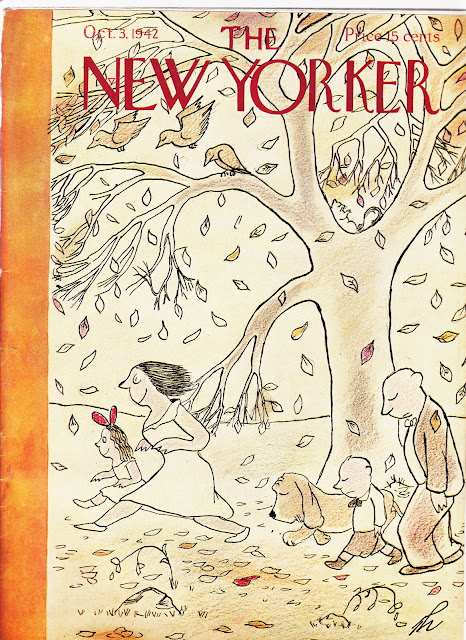Thurber (1894–1961) said, "I am not a dog-lover. To me, a dog-lover is a dog who is in love with another dog." All his life Thurber knew, owned, observed, drew, thought about, and wrote about dogs. This book explores the charming world of Thurber's hounds as recorded in his prose and drawings. Here are two of many his drawings: one cartoon (found on pages 64-65 of the book) and one New Yorker cover that I found online:
Caption: "The father belonged to some people who were driving through in a Packard."
The date on this New Yorker cover is October 3, 1942. Ha! I was not quite two-and-a-half years old, so obviously I did not read this issue of the magazine. Oh, I forgot to mention that Thurber's Dogs is another book that seems to have magically re-appeared among my books after my move.
James Thurber created some thirty volumes of humor, fiction, children's books, cartoons, and essays in just about as many years. A founding member of The New Yorker staff, Thurber wrote and illustrated such enduring books as The Thurber Carnival and My Life and Hard Times, which have appeared in countless editions and in dozens of languages throughout the world.
The Secret Life of Walter Mitty ~ by James Thurber, 1939, (introduction by Rosemary Thurber, 2013), short story, 15 pages, 10/10
This is probably my own personal favorite Thurber story. I haven't read it in years, so I downloaded it onto my Kindle yesterday and re-read it. This classic short story is about a man who escapes the tedium of his mundane life by retreating into his vivid imagination. This e-book features the original story, a selection of Thurber drawings, and a new introduction by Rosemary A. Thurber, the author’s daughter. Here's the plot from Wikipedia:
The short story deals with a vague and mild-mannered man who drives into Waterbury, Connecticut, with his wife for their regular weekly shopping and his wife's visit to the beauty parlor. During this time he has five heroic daydream episodes, each inspired by some detail of his mundane surroundings.
- The first is as a pilot of a U.S. Navy flying boat in a storm, followed by Mrs. Mitty's complaint that Mitty is "driving too fast."
- As he drives past a hospital, he imagines himself a magnificent surgeon performing a one-of-a-kind surgery.
- Later, a newsboy shouting about the "Waterbury Trial" begins Mitty's third fantasy, as a deadly assassin testifying in a courtroom.
- While waiting for his wife, he picks up an old copy of Liberty, reading "Can Germany Conquer the World Through the Air?" and begins his fourth daydream, as a Royal Air Force pilot volunteering for a daring suicide mission to bomb an ammunition dump.
- As the story ends, Mitty stands against a wall, smoking, and imagines himself facing a firing squad, "inscrutable to the last."
The author's biography (on p. 10) says that Thurber's contributions to The New Yorker, both as a writer and an artist, were instrumental in changing the character of American humor. In 1994, on the centennial celebration of his birthday, the United States Postal Service imprinted his self-portrait on the postage stamp.






No comments:
Post a Comment